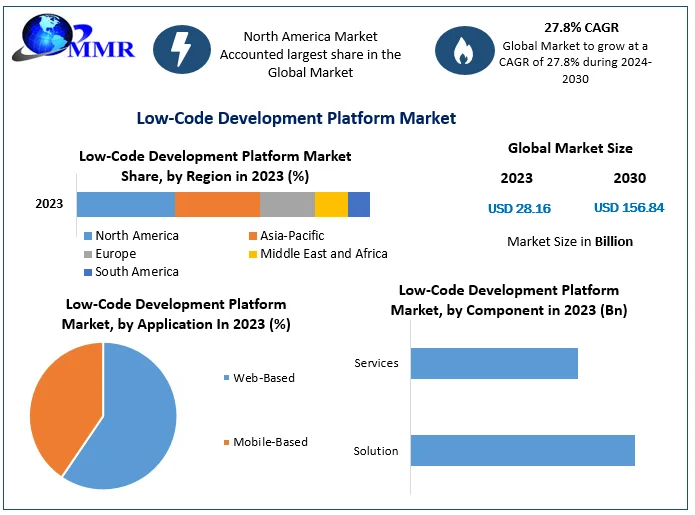Good Tips On Choosing application development with Low-code platforms
Good Tips On Choosing application development with Low-code platforms
Blog Article
Advantages Of Low Code Application Development For Non-Developers
Low-code app development improves accessibility for non-developers (often referred to as "citizen-developers") due to a few key factors.
Drag-anddrop Builders: Lowcode platform include drag-anddrop interfaces to allow nondevelopers to visually create applications, without needing code. This makes development more accessible to those with no technical backgrounds.
WYSIWYG editor: "What you see is the result you get" editors allow users to design interfaces, workflows and other features in a way that closely mimics the final outcome. They are easy to comprehend and utilize.
Simple Logic and Workflow:
Visual Workflow Design: Users can quickly design business processes and application logic by using diagrams, models, and flowcharts. They are simpler to use than traditional programming.
Pre-built Logical Components: A lot of low-code platforms have pre-built components for logic (e.g. loops, conditions) which can be easily configured. This eliminates the necessity to write complicated programs.
Reusable Components and Templates
Libraries of prebuilt templates Low-code platforms usually provide templates libraries for various types of application. This gives non-programmers the opportunity to start with a solid foundation and modify it as needed.
Reusable Modules and Widgets: Utilizing reusable modules and widgets, users can speed up the creation process, while also reducing the need for technical expertise.
Guided Development and Tutorials
Step-by-Step Guides: Platforms typically provide a development path with guidance, online tutorials, or on-screen directions to help those who are not developers in developing applications.
Interactive Tutorials. Interactive, hands on tutorials allow users to learn through doing.
Integration of existing tools:
Integration seamless Low-code platforms have been created to be able to seamlessly integrate with existing tools and systems for business (e.g. CRM, ERP) allowing non-developers create applications that fit into their workflows.
APIs, connectors: These tools simplify integration by allowing non-developers (or even end users) to link their applications with external services.
Collaboration Features:
Team Collaboration: Features such as real-time collaboration and shared workspaces enable non-developers to work with professional developers, business analysts, and other stakeholders effectively.
Role-based Access Control: Non developers can be assigned roles and access levels. This lets them participate in the development process without compromising security or functionality.
Automated Testing, Debugging and Debugging
Low-code platforms include tools for testing and debugging that are built-in. They automatize this process so it is easy for non-developers to ensure that their apps run.
Error highlighting: The system highlights issues and suggests fixes for non-developers.
The ability of low-code applications to facilitate development for those who are not developers is its main advantage. Low-code platforms offer intuitive, visual tools, guided user experiences, and allow business users to actively participate in creating updates, maintaining and enhancing applications. Take a look at the best https://www.wavemaker.com/low-code-application-development-platform/ for site examples including cross platform app development, cloud software applications, cross platform mobile app development, multiplatform mobile app development, software for app development, rapid action development, rapid applications, application modernisation, developing mobile apps, application development platforms and more.
Benefits Of Low-Code Application Development In Terms Of Cost-Effectiveness
The low-code method of application development is a cost-effective solution with many benefits. It's a fantastic option for companies who want to make the most of their budgets as well as create top-quality applications. Here are a few of the key advantages.
Lower Coding Requirements: Low coding platforms eliminate the need to code by hand which saves developers time as well as money. This results in lower labor costs.
We require less developers: Development that is low-code takes less time and is simpler. This means that fewer developers are required. Hiring and staffing costs can be reduced significantly.
More rapid time to market
Accelerated Development: Low-code platforms provide visual development tools, pre-built components and other features that enable rapid development of software. Companies can launch their products to market much faster. This could lead to more rapid growth in revenue and enhance competitive positioning.
Rapid Prototyping: Businesses can quickly create prototypes and then test them, which can cut down the amount of time needed in the development phase and allowing faster iterations based on user feedback.
Lower Maintenance Costs:
Due to their modularity and standard components, applications built on low-code platforms are simpler to maintain. It reduces the cost of maintenance and support.
Automated updates: A lot of low code platforms automatically handle updates and patches, making sure that the applications are safe and up-to-date without the need for a lengthy manual intervention.
Efficient Resource Utilization:
Platform contributions that are low-code let business users as well as other non-developers participate in the creation process. This allows employees and employers to collaborate, thereby reducing the dependency on high-paid developers.
Improved Utilization of IT Resources: IT departments are able to concentrate on more strategic projects rather than being bogged down by routine tasks of development which can increase overall efficiency and productivity.
The Scalable Pricing models
Subscription-Based Pricing: Many low-code platforms offer flexible, subscription-based pricing plans that grow with usage. This gives businesses the capability to adapt their spending according to the growth of their business and its needs without incurring large upfront costs.
Pay-As-You-Go Options Certain platforms offer pay-as-you-go options, ensuring that businesses only pay for the resources they utilize that are advantageous for small and start-up companies with limited funds.
Lowering Third-Party Costs of Software:
Low-code platforms come with built-in integrations and functionalities, which could reduce the cost of software subscriptions and licensing.
Pre-Built Integrations: The existence of pre-built integrations that integrate with the most popular platforms and services eliminates the requirement for custom development, saving both time and money.
Improved ROI:
Improved ROI: Businesses can get a better return on investment for their apps by combining speedy development, lower costs and a faster times to market.
Increased agility: Businesses are able to adjust quickly to changes in the market or to customer demands which enables businesses to remain relevant and benefit from new opportunities.
Train for less:
User-Friendly Interfaces: Low code platforms offer intuitive and easy-to-use interfaces, which decreases the learning curve.
Accessible Resources that are accessible. Many low-code platforms provide comprehensive training material including tutorials, training, and community support. They make it less necessary for formal education, which can be expensive.
A more efficient collaboration
Enhance Collaboration Tool The built-in collaboration tool improves collaboration and communication among team members. This results in better development processes and also reduces the cost of projects.
Unified Development Environment: A single integrated development environment helps simplify workflows and decreases the difficulties and expenses associated with managing multiple tools and platforms.
Overall, the cost-effectiveness of developing low-code applications stems from its ability to cut development and maintenance costs and speed up the time to market, improve the utilization of resources, and offer flexibility in pricing. These factors combine to deliver significant financial benefits for businesses and make low-code development a viable choice for organizations aiming to maximize their development budgets while achieving robust, scalable and top-quality applications. See the recommended Legacy application modernization with Low-code info for blog tips including jdbc server, app dev platform, app modernization, cloud software applications, mobile development platforms, cross platform mobile development, rapid app development, azure sql databases, cloud software applications, application modernisation and more.
Benefits Of Low-Code Application Development In Terms Of Limitations And Customization
Low-code development is a balanced approach to addressing issues, while allowing for the possibility of personalization. Here are the key benefits:Handling the limitations
The Challenge of Overcoming Complexity Barriers
Simple Development: Low-code platforms minimize complexity by providing templates and components pre-built for you which allow rapid development and deployment for complicated applications.
Guided Workflows: A lot of platforms offer guided workflows and wizards to assist developers in navigating through complicated processes, reducing the chance of making mistakes and making sure that the process is consistent.
Scalability Solutions
Scalability is built in: Low-code platform often includes capabilities that permit scalable architecture. Applications are able to handle higher workloads with minimal changes.
Performance Monitoring: tools for monitoring and optimizing performance are built in the application to ensure that it is efficient, regardless of how it expands.
Security and compliance:
Integrated Security Features: Low-code systems include security features such as encryption, access control based on role and automated compliance checks to address security issues that are common.
Regular Updates: Platforms regularly change their security protocols as well as security measures to ensure that applications are protected against emerging threats.
Customization capabilities:
Extensibility:
Custom Code Integration : Low-code platforms often allow the integration of customized codes (e.g. JavaScript, Python) that allows developers to enhance the capabilities beyond what the standard offers.
Custom Modules and Plugins: Developers have the option to create customized modules or plugins in order to customize specific functionality to meet the specific requirements of a particular business.
APIs and Integration
API Support: Comprehensive APIs support is available to facilitate seamless integration and communication to external systems.
Third Party Services: Low-code platforms usually have pre-built connectors to well-known third-party services, making it simpler to integrate and customize applications.
Flexible UI/UX:
Customizable interfaces: Users can customize and design their own user interfaces which will provide users with a customized experience.
Responsive Designs: The applications can be tailored to fit various screen sizes and devices.
Business Logic Customization:
Visual Workflow Builds Visual tools permit customization of workflows and business rules, and also to create complex custom processes.
Platforms can be equipped with conditional Logic which permits the creation of custom scripts to address particular scenarios and business rules.
Data Management
Custom Data Models Developers are able to build custom data models customized to meet specific business requirements. This will ensure that the handling of data is customized for every application.
Advanced Data Processing: The integration of advanced tools and capabilities for data processing allows customizations in the way data is processed in an application.
Balancing limitations with customisation:
Frameworks & Standards
Low-code Platforms Support Industry Best practices and standards: Low code platforms encourage the adherence of the industry's best standards and practices. This makes it easier to maintain top-quality, secure, and scalable applications.
Governance Frameworks Inbuilt governance frameworks will ensure that the customizations don't affect the security, integrity, or compliance of the software.
Iterative Development and Feedback:
Rapid prototyping: The capacity to quickly prototype and test changes allows developers to modify their designs based on feedback from users improving the app to meet the needs of users.
Continuous Improvement: Platforms using low-code enable continuous improvement which allow for customization and improvement when the requirements of business change.
User Empowerment
The empowerment of citizens-developers through low-code platforms increase the number of developers who are capable of improving and customizing applications by allowing them to customize through an intuitive user interface.
Support and Training Resources: Many platforms provide extensive training and support materials to help users customize applications without compromising their performance or stability.
Low-code development is an effective framework that permits a lot of flexibility while also addressing limitations. This balance lets businesses create and maintain functional apps tailored to their needs while ensuring high standards of quality, security and the ability to scale.